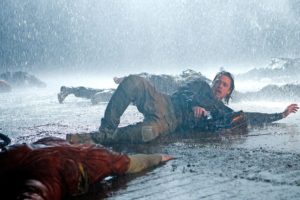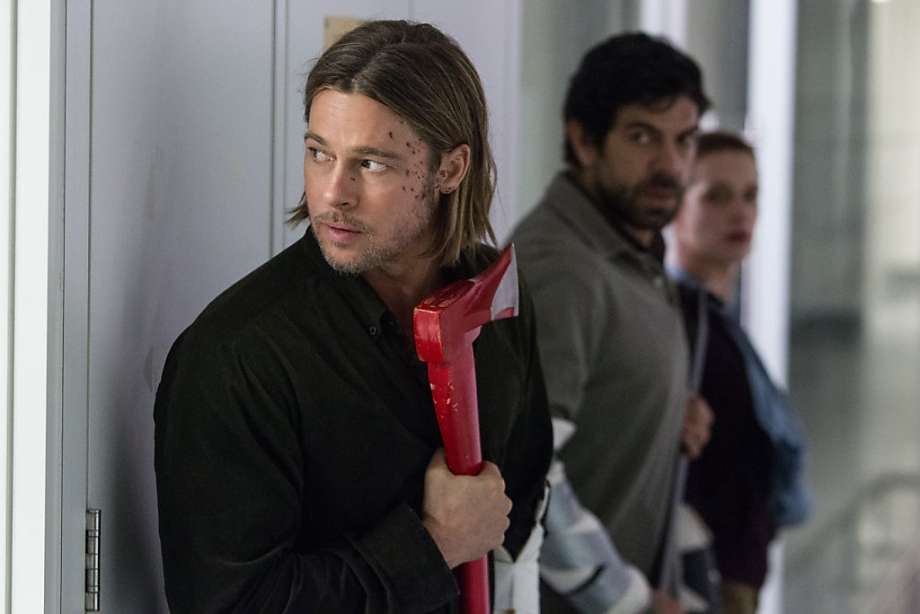In my first review for The Movie Buff, I wanted to write a long flowery introduction about my history as a horror movie and specifically a zombie movie fan. But considering how different “World War Z” is from every zombie movie that has come before it, that context is unnecessary. You don’t need to know anything about Max Brooks’ novel that this movie is (very loosely) based on before going into this film. You don’t even need to be a zombie fan in a traditional sense; in fact, traditional zombie fans may be the most disappointed with this globe-trotting disaster epic. Because it is most certainly, not a traditional zombie movie.
Taking a cue from Zack Snyder’s “Dawn of the Dead” remake, the film starts with footage of recent news stories ripped from our own headlines (avian flu, civil unrest) setting the stage for what will come. Gerry Lane (Brad Pitt), a former UN investigator and his family are stuck in gridlock when the epidemic hits Philadelphia. And as a life-long Philadelphian, I can confirm that if the zombie apocalypse hit around City Hall during the A.M. rush hour, it would pretty much play out the way it does here: mass hysteria, cars crashing, explosions, and the hero of the film stealing a car.
It’s here that the film first hints that this won’t be like numerous other zombie movies of the past. Not just seeing the protagonist almost immediately abandoning legal and social mores in the interest of protecting himself and his family; but with the first view of the zombies in this film. The promotional materials showed a few scenes of masses of zombies, but never really showed a single zombie. The first extended shot of a single zombie has it running at a car at full speed and head butting her way through the windshield and biting the driver. And then, instead of sticking around to feast on a banquet of driver sweetbreads, the zombie moves on. The compulsion in this film is not to devour humanity as much as it is to infect it.

Also worth noting is the movement of the zombies. Shambling zombies are passé. With the exception of “The Walking Dead,” most popular zombie fiction of the 21 Century shows running zombies; this isn’t what makes “World War Z’s” creatures unique. What makes them stand out is their body language. Bodies contort and run at top speed as though being lead by remote control against whatever will they have left. The compulsion to infect is, literally, the driving force.
As the movie continues, Gerry is sent around the world with a team of soldiers and a scientist, to try and find the origin of the zombie plague. His quest takes him from the United States to South Korea, to Jerusalem, and finally Wales, often at a breakneck pace. This represents another change from the standard zombie movie. No more finding a defensible building to hide away in, this is a movie that lives by the axiom of its lead character: “movement is life.”
Much ado has been made of the number of reshoots and the rewritten third act. The fact of the matter is, many movies have changes and reshoots along the way, so that in and of itself isn’t indicative of a troubled picture. Unfortunately, even without that meta-knowledge, it becomes painfully obvious that the third act was stitched onto a different movie than one where it would’ve belonged. It drops the pace down when we should be speeding towards our conclusion. Suffice it to say, the solution to the zombie problem is found, but it’s discovered about 20 minutes before the slow (albeit tense) finish.
 Other issues start to show their heads at about the halfway mark. Prior to Gerry’s trip to Jerusalem, most of the zombies were shown in the dark and in shadows. But once the action hits Israel, with the bright, harsh light of the sun blasting down on the desert, the CGI zombies start to look a little too cartoony. An unrealistic sheen covers their skin and they move without any real weight. It’s a common issue when trying to render multiple CGI characters at once, but it’s very jarring when going from actual stunt performers to CG hordes.
Other issues start to show their heads at about the halfway mark. Prior to Gerry’s trip to Jerusalem, most of the zombies were shown in the dark and in shadows. But once the action hits Israel, with the bright, harsh light of the sun blasting down on the desert, the CGI zombies start to look a little too cartoony. An unrealistic sheen covers their skin and they move without any real weight. It’s a common issue when trying to render multiple CGI characters at once, but it’s very jarring when going from actual stunt performers to CG hordes.
Even with those issues, “World War Z” is a unique and welcome entry into the zombie genre. Not focused on survivalism, or even the evils that men do when facing the end of the world; it is a disaster movie where zombies are the natural disaster. We’ve reached a point in zombie cinema where filmmakers no longer feel beholden to the old rules of a zombie movie. Sure there are some tropes that are hard to avoid, but the fact that Brad Pitt, Marc Forrester & Co. are moving away from the claustrophobic, allegory filled zombie films of the past means that steps are being made in the right direction.
– by Jared Moore



2 Comments
First off nice writing, secondly I disagree with everything you said. I found this film slow and with horrible pacing. All characters lacked depth and interest for the viewer. By the end I was wishing a zombie would infect me so I could stop watching.
Pingback: » 28 Days Later